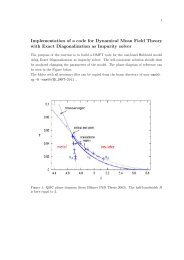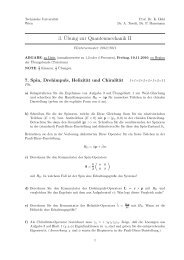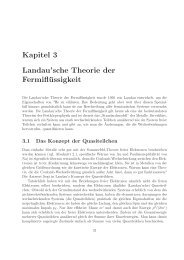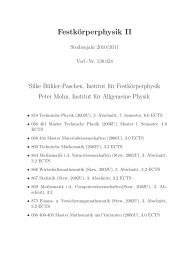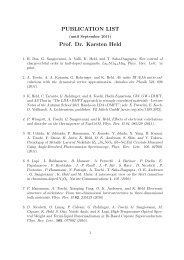IV) Materials calculations with dynamical mean field theory (DMFT)
IV) Materials calculations with dynamical mean field theory (DMFT)
IV) Materials calculations with dynamical mean field theory (DMFT)
You also want an ePaper? Increase the reach of your titles
YUMPU automatically turns print PDFs into web optimized ePapers that Google loves.
<strong>IV</strong>) <strong>Materials</strong> <strong>calculations</strong> <strong>with</strong><strong>dynamical</strong> <strong>mean</strong> <strong>field</strong> <strong>theory</strong> (<strong>DMFT</strong>)Literature:<strong>DMFT</strong>: Kotliar and Vollhardt, Physics Today 57, No. 3 (March), 53 (2004).Georges et al., Rev. Mod. Phys. 68, 13 (1996).LDA+<strong>DMFT</strong>: Kotliar et al., Rev. Mod. Phys. 78, 865 (2006).Held, Adv. Phys. 56, 829 (2007).
Ab-initio electronic Hamiltonian(non-relativistic/Born-Oppenheimer approximation)
Ab-initio electronic Hamiltonian(non-relativistic/Born-Oppenheimer approximation)
Ab-initio electronic Hamiltonian(non-relativistic/Born-Oppenheimer approximation)kinetic energy lattice potential Coulomb interactionH = X i"− 2 ∆ i2m e+ X l−e 24πɛ 0Z l|r i − R l |#+ 1 2Xi≠je 24πɛ 01|r i − r j |
Ab-initio electronic Hamiltonian(non-relativistic/Born-Oppenheimer approximation)kinetic energy lattice potential Coulomb interactionH = X i"− 2 ∆ i2m e+ X l−e 24πɛ 0Z l|r i − R l |#+ 1 2Xi≠je 24πɛ 01|r i − r j |LDA bandstructure corresponds toH LDA = X i"− 2 ∆ i2m e+ X l−e 24πɛ 01|r i − R l | + Zd 3 r#e2 1LDAρ(r) + Vxc (ρ(r i ))4πɛ 0 |r i − r|
Ab-initio electronic Hamiltonian(non-relativistic/Born-Oppenheimer approximation)kinetic energy lattice potential Coulomb interactionH = X i"− 2 ∆ i2m e+ X l−e 24πɛ 0Z l|r i − R l |#+ 1 2Xi≠je 24πɛ 01|r i − r j |LDA bandstructure corresponds toH LDA = X i"− 2 ∆ i2m e+ X l−e 24πɛ 01|r i − R l | + Zd 3 r#e2 1LDAρ(r) + Vxc (ρ(r i ))4πɛ 0 |r i − r|LDA + local Coulomb interactionĤ = X klmσɛ LDAklm ĉ†klσĉkmσ+ 1 2| {z }H LDAXU σσ′lmi lσmσ ′ˆn ilσ ˆn imσ ′ − ∆ɛ X imσˆn imσU’Um=2U’−Jm=1
Ab-initio electronic Hamiltonian(non-relativistic/Born-Oppenheimer approximation)kinetic energy lattice potential Coulomb interactionH = X i"− 2 ∆ i2m e+ X l−e 24πɛ 0Z l|r i − R l |#+ 1 2Xi≠je 24πɛ 01|r i − r j |LDA bandstructure corresponds toH LDA = X i"− 2 ∆ i2m e+ X l−e 24πɛ 01|r i − R l | + Zd 3 r#e2 1LDAρ(r) + Vxc (ρ(r i ))4πɛ 0 |r i − r|LDA + local Coulomb interactionĤ = X ɛ LDAklm ĉ†klσĉkmσ+ 1 XU σσ′lm2 ˆn ilσ ˆn imσ ′ − ∆ɛ X ˆn imσU’ U’−Jklmσi lσmσ| {z }′ imσm=1H LDA U• non-local Coulomb interaction → Hartree term (to leading order in 1/Z; contained in LDA)• constrained LDA ⇒ U, J, V =U−2J, ∆ɛ(McMahan et al.’88, Gunnarsson et al.’89)m=2
Constrained LDA1. Calculate LDA energies E(n d ) for constrained problem, i.e., <strong>with</strong>out hopping of d (orf) electrons, for differnet numbers n d of d (or f) electrons.2. Adjust U (J) and ∆ɛ inĤ that these LDA energies are obtained.E000 111000 111000 111000 111n −1 n n +1dd
LDA+UAnisimov et al.’91LDA+U: SolveĤ by symmetry broken HartreeĤ = H LDA + XU σσ′lmi lσmσ ′ˆn ilσ 〈ˆn imσ ′〉 − ∆ɛ X imσˆn imσ − 1 2Xi lσmσ ′ U σσ′lm 〈ˆn ilσ 〉 〈ˆn imσ ′〉E000000000111111111000000000111111111000000000111111111000000000111111111000000000111111111000000000111111111NkU000000000111111111000000000111111111000000000111111111000000000000000000111111111111111111000000001111111100000000111111110000000011111111000000001111111100000000111111110000000011111111LDALDA+U
LDA+<strong>DMFT</strong>SolveĤ by <strong>dynamical</strong> <strong>mean</strong> <strong>field</strong> <strong>theory</strong>(Anisimov et al.’97)UUUΣ Σ Σ<strong>DMFT</strong>UUUΣUΣUUUΣΣΣmaterial specific lattice problem ĤAnderson impurity model + Dyson equation(Metzner, Vollhardt’89; Georges, Kotliar’92)
LDA+<strong>DMFT</strong>SolveĤ by <strong>dynamical</strong> <strong>mean</strong> <strong>field</strong> <strong>theory</strong>(Anisimov et al.’97)UUUΣ Σ Σ<strong>DMFT</strong>UUUΣUΣUUUΣΣΣmaterial specific lattice problem ĤAnderson impurity model + Dyson equation(Metzner, Vollhardt’89; Georges, Kotliar’92)Spectral density functional <strong>theory</strong>: E[ρ, G ii (ω)]Savrasov, Kotliar’01
LDA+<strong>DMFT</strong> many body physicsLDA LDA+<strong>DMFT</strong> LDA+U ∗0 U/W ∞U: local Coulomb interaction, W : LDA bandwidth
¡ ¡ ¡ ¡ ¡ ¡ ¡ ¡¡ ¡ ¡ ¡ ¡ ¡ ¡ ¡¡ ¡ ¡ ¡ ¡ ¡ ¡ ¡¡ ¡ ¡ ¡ ¡ ¡ ¡ ¡¡ ¡ ¡ ¡ ¡ ¡ ¡ ¡¡ ¡ ¡ ¡ ¡ ¡ ¡ ¡LDA+<strong>DMFT</strong> many body physicsE¡ ¡ ¡ ¡ ¡ ¡ ¡ ¡Nweakly correlated metalkLDA LDA+<strong>DMFT</strong> LDA+U ∗0 U/W ∞U: local Coulomb interaction, W : LDA bandwidth
¡ ¡ ¡ ¡ ¡ ¡ ¡ ¡¡ ¡ ¡ ¡ ¡ ¡ ¡ ¡¡ ¡ ¡ ¡ ¡ ¡ ¡ ¡¡ ¡ ¡ ¡ ¡ ¡ ¡ ¡¡ ¡ ¡ ¡ ¡ ¡ ¡¡ ¡ ¡ ¡ ¡ ¡ ¡¡ ¡ ¡ ¡ ¡ ¡ ¡¡ ¡ ¡ ¡ ¡ ¡ ¡LDA+<strong>DMFT</strong> many body physicsEE¡ ¡ ¡ ¡ ¡ ¡ ¡ ¡¡ ¡ ¡ ¡ ¡ ¡ ¡ ¡¡ ¡ ¡ ¡ ¡ ¡ ¡ ¡Uor¡ ¡ ¡ ¡ ¡ ¡ ¡¡ ¡ ¡ ¡ ¡ ¡ ¡Nweakly correlated metalkNMott-Hubbard insulatorkLDA LDA+<strong>DMFT</strong> LDA+U ∗0 U/W ∞U: local Coulomb interaction, W : LDA bandwidth
¡ ¡ ¡ ¡ ¡ ¡ ¡ ¡¡ ¡ ¡ ¡ ¡ ¡ ¡ ¡¡ ¡ ¡ ¡ ¡ ¡ ¡ ¡¡ ¡ ¡ ¡ ¡ ¡ ¡ ¡¡ ¡ ¡ ¡ ¡ ¡ ¡¡ ¡ ¡ ¡ ¡ ¡ ¡¡ ¡ ¡ ¡ ¡ ¡ ¡¡ ¡ ¡ ¡ ¡ ¡ ¡LDA+<strong>DMFT</strong> many body physicsEEE¡ ¡ ¡ ¡ ¡ ¡ ¡ ¡¡ ¡ ¡ ¡ ¡ ¡ ¡ ¡¡ ¡ ¡ ¡ ¡ ¡ ¡ ¡Z
¡ ¡ ¡ ¡ ¡ ¡ ¡ ¡¡ ¡ ¡ ¡ ¡ ¡ ¡ ¡¡ ¡ ¡ ¡ ¡ ¡ ¡ ¡¡ ¡ ¡ ¡ ¡ ¡ ¡ ¡¡ ¡ ¡ ¡ ¡ ¡ ¡¡ ¡ ¡ ¡ ¡ ¡ ¡¡ ¡ ¡ ¡ ¡ ¡ ¡¡ ¡ ¡ ¡ ¡ ¡ ¡LDA+<strong>DMFT</strong> many body physicsEEE¡ ¡ ¡ ¡ ¡ ¡ ¡ ¡¡ ¡ ¡ ¡ ¡ ¡ ¡ ¡¡ ¡ ¡ ¡ ¡ ¡ ¡ ¡Z
¡ ¡ ¡ ¡ ¡ ¡ ¡ ¡¡ ¡ ¡ ¡ ¡ ¡ ¡ ¡¡ ¡ ¡ ¡ ¡ ¡ ¡ ¡¡ ¡ ¡ ¡ ¡ ¡ ¡ ¡¡ ¡ ¡ ¡ ¡ ¡ ¡¡ ¡ ¡ ¡ ¡ ¡ ¡¡ ¡ ¡ ¡ ¡ ¡ ¡¡ ¡ ¡ ¡ ¡ ¡ ¡LDA+<strong>DMFT</strong> many body physicsEEE¡ ¡ ¡ ¡ ¡ ¡ ¡ ¡¡ ¡ ¡ ¡ ¡ ¡ ¡ ¡¡ ¡ ¡ ¡ ¡ ¡ ¡ ¡Z
¡ ¡ ¡ ¡ ¡ ¡ ¡ ¡¡ ¡ ¡ ¡ ¡ ¡ ¡ ¡¡ ¡ ¡ ¡ ¡ ¡ ¡ ¡¡ ¡ ¡ ¡ ¡ ¡ ¡ ¡¡ ¡ ¡ ¡ ¡ ¡ ¡¡ ¡ ¡ ¡ ¡ ¡ ¡¡ ¡ ¡ ¡ ¡ ¡ ¡¡ ¡ ¡ ¡ ¡ ¡ ¡LDA+<strong>DMFT</strong> many body physicsEEE¡ ¡ ¡ ¡ ¡ ¡ ¡ ¡¡ ¡ ¡ ¡ ¡ ¡ ¡ ¡¡ ¡ ¡ ¡ ¡ ¡ ¡ ¡Z
¡ ¡ ¡ ¡ ¡ ¡ ¡ ¡¡ ¡ ¡ ¡ ¡ ¡ ¡ ¡¡ ¡ ¡ ¡ ¡ ¡ ¡ ¡¡ ¡ ¡ ¡ ¡ ¡ ¡ ¡¡ ¡ ¡ ¡ ¡ ¡ ¡¡ ¡ ¡ ¡ ¡ ¡ ¡¡ ¡ ¡ ¡ ¡ ¡ ¡¡ ¡ ¡ ¡ ¡ ¡ ¡LDA+<strong>DMFT</strong> many body physicsEEE¡ ¡ ¡ ¡ ¡ ¡ ¡ ¡¡ ¡ ¡ ¡ ¡ ¡ ¡ ¡¡ ¡ ¡ ¡ ¡ ¡ ¡ ¡Z
LDA+<strong>DMFT</strong> — overviewMetzner, Vollhardt PRL’89 — simplifications in d = ∞Georges, Kotliar PRB’89 — <strong>DMFT</strong>Anisimov et al. EPJ’97 — first LDA+<strong>DMFT</strong> calculation, LaTiO 3simplified <strong>DMFT</strong> solverKH, Keller, Eyert, Vollhardt, Anisimov PRL’01 — Mott-Hubbard transition in V2O 3KH, McMahan, Scalettar PRL’01 — Volume collapse in CeLichtenstein, Katsnelson PRL’01 — Ferromagnetism in Fe and NiSavrasov, Kotliar, Abrahams Nature’01 — δ-Pu
LDA+<strong>DMFT</strong> — overviewMetzner, Vollhardt PRL’89 — simplifications in d = ∞Georges, Kotliar PRB’89 — <strong>DMFT</strong>Anisimov et al. EPJ’97 — first LDA+<strong>DMFT</strong> calculation, LaTiO 3simplified <strong>DMFT</strong> solverKH, Keller, Eyert, Vollhardt, Anisimov PRL’01 — Mott-Hubbard transition in V2O 3KH, McMahan, Scalettar PRL’01 — Volume collapse in CeLichtenstein, Katsnelson PRL’01 — Ferromagnetism in Fe and NiSavrasov, Kotliar, Abrahams Nature’01 — δ-Pu... ∼ 300 publications by now ...
LDA+<strong>DMFT</strong> — overviewMetzner, Vollhardt PRL’89 — simplifications in d = ∞Georges, Kotliar PRB’89 — <strong>DMFT</strong>Anisimov et al. EPJ’97 — first LDA+<strong>DMFT</strong> calculation, LaTiO 3simplified <strong>DMFT</strong> solverKH, Keller, Eyert, Vollhardt, Anisimov PRL’01 — Mott-Hubbard transition in V2O 3KH, McMahan, Scalettar PRL’01 — Volume collapse in CeLichtenstein, Katsnelson PRL’01 — Ferromagnetism in Fe and NiSavrasov, Kotliar, Abrahams Nature’01 — δ-Pu... ∼ 300 publications by now ...P. W. Anderson, The future lies ahead in “Recent progress in many-body theories” (WorldScientific, 2006):In <strong>theory</strong>, the big news is the <strong>DMFT</strong> which gives us a systematic way todeal <strong>with</strong> the major effects of strong correlations. After nearly 50 years,we are finally able to understand the Mott transition, for instance, at leastin three dimensions, and to model the Kondo volume collapse in cerium.
Dynamical <strong>mean</strong> <strong>field</strong> <strong>theory</strong> (<strong>DMFT</strong>)d dimensional quantum system ≡ d + 1 (+time) dimensional classical system
Dynamical <strong>mean</strong> <strong>field</strong> <strong>theory</strong> (<strong>DMFT</strong>)d dimensional quantum system ≡ d + 1 (+time) dimensional classical systemMean <strong>field</strong> theories:
Dynamical <strong>mean</strong> <strong>field</strong> <strong>theory</strong> (<strong>DMFT</strong>)d dimensional quantum system ≡ d + 1 (+time) dimensional classical systemMean <strong>field</strong> theories:Weiss <strong>mean</strong> <strong>field</strong> <strong>theory</strong>:<strong>mean</strong> <strong>field</strong> in d dimensions (Ising) or d + 1 dimensions (Heisenberg)
Dynamical <strong>mean</strong> <strong>field</strong> <strong>theory</strong> (<strong>DMFT</strong>)d dimensional quantum system ≡ d + 1 (+time) dimensional classical systemMean <strong>field</strong> theories:Weiss <strong>mean</strong> <strong>field</strong> <strong>theory</strong>:<strong>mean</strong> <strong>field</strong> in d dimensions (Ising) or d + 1 dimensions (Heisenberg)Hartree Fock:<strong>mean</strong> <strong>field</strong> in d + 1 dimensions
Dynamical <strong>mean</strong> <strong>field</strong> <strong>theory</strong> (<strong>DMFT</strong>)d dimensional quantum system ≡ d + 1 (+time) dimensional classical systemMean <strong>field</strong> theories:Weiss <strong>mean</strong> <strong>field</strong> <strong>theory</strong>:<strong>mean</strong> <strong>field</strong> in d dimensions (Ising) or d + 1 dimensions (Heisenberg)Hartree Fock:<strong>mean</strong> <strong>field</strong> in d + 1 dimensions<strong>DMFT</strong>:<strong>mean</strong> <strong>field</strong> in d spatial dimensionsbut not <strong>mean</strong>-<strong>field</strong> in timequantum fluctuations (time) keptspatial fluctuations neglected
First something easier...
First something easier......Weiss <strong>mean</strong> <strong>field</strong> <strong>theory</strong>Ising modelĤ = J ∑ 〈ij〉s i s jLimit d → ∞ or Z → ∞; proper scaling J = J ∗ /Z
First something easier......Weiss <strong>mean</strong> <strong>field</strong> <strong>theory</strong>Ising modelĤ = J ∑ 〈ij〉s i s jLimit d → ∞ or Z → ∞; proper scaling J = J ∗ /Z⇒ Weiss <strong>mean</strong> <strong>field</strong> <strong>theory</strong> becomes exact〈s i 〉 = ∑ s i e −βJ∗ s i 〈s j 〉 /[e βJ∗ 〈s j 〉 + e −βJ∗ 〈s j 〉 ]s i =±1
First something easier......Weiss <strong>mean</strong> <strong>field</strong> <strong>theory</strong>Ising modelĤ = J ∑ 〈ij〉s i s jLimit d → ∞ or Z → ∞; proper scaling J = J ∗ /Z⇒ Weiss <strong>mean</strong> <strong>field</strong> <strong>theory</strong> becomes exact〈s i 〉 = ∑ s i e −βJ∗ s i 〈s j 〉 /[e βJ∗ 〈s j 〉 + e −βJ∗ 〈s j 〉 ]s i =±121 3WMFTJ * oo
First something easier......Weiss <strong>mean</strong> <strong>field</strong> <strong>theory</strong>Ising modelĤ = J ∑ 〈ij〉s i s jLimit d → ∞ or Z → ∞; proper scaling J = J ∗ /Z⇒ Weiss <strong>mean</strong> <strong>field</strong> <strong>theory</strong> becomes exact〈s i 〉 = ∑ s i e −βJ∗ s i 〈s j 〉 /[e βJ∗ 〈s j 〉 + e −βJ∗ 〈s j 〉 ]s i =±121 3<strong>DMFT</strong>σlΣ (ω)oo
First something easier......Weiss <strong>mean</strong> <strong>field</strong> <strong>theory</strong>Ising modelĤ = J ∑ 〈ij〉s i s jLimit d → ∞ or Z → ∞; proper scaling J = J ∗ /Z⇒ Weiss <strong>mean</strong> <strong>field</strong> <strong>theory</strong> becomes exact〈s i 〉 = ∑ s i e −βJ∗ s i 〈s j 〉 /[e βJ∗ 〈s j 〉 + e −βJ∗ 〈s j 〉 ]s i =±121 3WMFTJ * oo
<strong>DMFT</strong> self-consistency cycleG(ω) = 1V BZ∫BZG 0 = (G −1 + Σ) −1d 3 k [ ω1 + µ1 − ɛ(k) − Σ(ω)] −1Solve AIM defined by G 0 ⇒ GΣ new = (G 0 ) −1 − G −1Iterate <strong>with</strong> Σ=Σ new until ||Σ − Σ new || < ε
<strong>DMFT</strong> self-consistency cycleG(ω) = 1V BZ∫BZG 0 = (G −1 + Σ) −1d 3 k [ ω1 + µ1 − ɛ(k) − Σ(ω)] −1Solve AIM defined by G 0 ⇒ GΣ new = (G 0 ) −1 − G −1Iterate <strong>with</strong> Σ=Σ new until ||Σ − Σ new || < ε21 3<strong>DMFT</strong>σlΣ (ω)oo
<strong>DMFT</strong> self-consistency cycleG(ω) = 1V BZ∫BZG 0 = (G −1 + Σ) −1d 3 k [ ω1 + µ1 − ɛ(k) − Σ(ω)] −1Solve AIM defined by G 0 ⇒ GΣ new = (G 0 ) −1 − G −1Iterate <strong>with</strong> Σ=Σ new until ||Σ − Σ new || < εUUUΣ Σ Σ<strong>DMFT</strong>UUUΣUΣUUUΣΣΣ
<strong>DMFT</strong> self-consistency cycleG(ω) = 1V BZ∫BZG 0 = (G −1 + Σ) −1d 3 k [ ω1 + µ1 − ɛ(k) − Σ(ω)] −1Solve AIM defined by G 0 ⇒ GΣ new = (G 0 ) −1 − G −1Iterate <strong>with</strong> Σ=Σ new until ||Σ − Σ new || < εUUUΣ Σ Σ<strong>DMFT</strong>UUUΣUΣUUUΣΣΣ
Mott-Hubbard metal-insulator transition
Experimental motivation — (Cr x V 1−x ) 2 O 3McWhan et al.’73Cr-doping x ≡ volume changeMcWhan, Remeika’70
Experimental motivation — (Cr x V 1−x ) 2 O 3McWhan et al.’73Cr-doping x ≡ volume changeMcWhan, Remeika’70
Experimental motivation — (Cr x V 1−x ) 2 O 3←→McWhan et al.’73Cr-doping x ≡ volume changeMcWhan, Remeika’70←→ Mott-Hubbard transitionU: local Coulomb interactionW : bandwidth
One-band Hubbard modelĤ = − t∗√Z1∑〈ij〉 σĉ σ†i ĉ σ j + U ∑ iĉ ↑ †i ĉ ↑ i ĉ↓ †i ĉ ↓ ihalf-filling — paramagnetic phase (frustration)
One-band Hubbard modelĤ = − t∗√Z1∑〈ij〉 σĉ σ†i ĉ σ j + U ∑ iĉ ↑ †i ĉ ↑ i ĉ↓ †i ĉ ↓ ihalf-filling — paramagnetic phase (frustration)Bethe lattice Z 1 → ∞N(E)−D/2 D/2E
Numerical results – spectrumSpectrum A(ω) = − 1 π ImG(ω)<strong>DMFT</strong>(NRG) Bulla’99
Numerical results – spectrumSpectrum A(ω) = − 1 π ImG(ω)<strong>DMFT</strong>(NRG) Bulla’99U=0Α(ω)−8 −4 0 4 8ω
Numerical results – spectrumSpectrum A(ω) = − 1 π ImG(ω)<strong>DMFT</strong>(NRG) Bulla’99U=0.8Α(ω)−8 −4 0 4 8ω
Numerical results – spectrumSpectrum A(ω) = − 1 π ImG(ω)<strong>DMFT</strong>(NRG) Bulla’99U=0.8 U=1.2Α(ω)−8 −4 0 4 8ω
Numerical results – spectrumSpectrum A(ω) = − 1 π ImG(ω)<strong>DMFT</strong>(NRG) Bulla’99U=0.8 U=1.2 U=2Α(ω)−8 −4 0 4 8ω
Numerical results – spectrumSpectrum A(ω) = − 1 π ImG(ω)<strong>DMFT</strong>(NRG) Bulla’99U=0.8 U=1.2U=2.8Α(ω)−8 −4 0 4 8ω
Numerical results – spectrumSpectrum A(ω) = − 1 π ImG(ω)<strong>DMFT</strong>(NRG) Bulla’99U=0.8 U=1.2U=2.8 U=3.6Α(ω)−8 −4 0 4 8ω
Numerical results – spectrumSpectrum A(ω) = − 1 π ImG(ω)<strong>DMFT</strong>(NRG) Bulla’99U=0.8 U=1.2U=2.8 U=3.6 U=4.4Α(ω)−8 −4 0 4 8ω
Numerical results – spectrumSpectrum A(ω) = − 1 π ImG(ω)<strong>DMFT</strong>(NRG) Bulla’99U=0.8 U=1.2U=2.8 U=3.6 U=4.4 U=5.2Α(ω)−8 −4 0 4 8ω
Numerical results – spectrumSpectrum A(ω) = − 1 π ImG(ω)<strong>DMFT</strong>(NRG) Bulla’99U=0.8 U=1.2U=2.8 U=3.6 U=4.4 U=5.2 U=5.6Α(ω)−8 −4 0 4 8ω
Numerical results – spectrumSpectrum A(ω) = − 1 π ImG(ω)<strong>DMFT</strong>(NRG) Bulla’99U=0.8 U=1.2U=2.8 U=3.6 U=4.4 U=5.2 U=5.6 U=5.8Α(ω)−8 −4 0 4 8ω
Numerical results – spectrumSpectrum A(ω) = − 1 π ImG(ω)<strong>DMFT</strong>(NRG) Bulla’99U=0.8 U=1.2U=2.8 U=3.6 U=4.4 U=5.2 U=5.6 U=5.8 U=6Α(ω)−8 −4 0 4 8ω
Numerical results – spectrumSpectrum A(ω) = − 1 π ImG(ω)<strong>DMFT</strong>(NRG) Bulla’99U=0.8 U=1.2U=2.8 U=3.6 U=4.4 U=5.2U=5.8 U=6 U=5.6Α(ω)−8 −4 0 4 8ω
Numerical results – spectrumSpectrum A(ω) = − 1 π ImG(ω)<strong>DMFT</strong>(NRG) Bulla’99U=0.8 U=1.2U=2.8 U=3.6 U=4.4 U=5.2U=5.8 U=6 U=5.6Α(ω)−8 −4 0 4 8ωMetal – Fermi liquidΣ(ω) = (1 − 1 Z )ω − iBω2 + O(ω 3 )m ∗m = 1 Z = 1 − ∂ReΣ(ω+i0+ ) ∣∂ωA(0) fixed∣ω=0
Numerical results – spectrumSpectrum A(ω) = − 1 π ImG(ω)U=0.8 U=1.2U=2.8 U=3.6 U=4.4 U=5.2U=5.8 U=6 U=5.6<strong>DMFT</strong>(NRG) Bulla’99Quasiparticle weight<strong>DMFT</strong>(PQMC) Feldbacher, kh, Assaad’04Α(ω)−8 −4 0 4 8ωMetal – Fermi liquidΣ(ω) = (1 − 1 Z )ω − iBω2 + O(ω 3 )m ∗m = 1 Z = 1 − ∂ReΣ(ω+i0+ ) ∣∂ωA(0) fixed∣ω=0
Numerical results – spectrumSpectrum A(ω) = − 1 π ImG(ω)U=0.8 U=1.2U=2.8 U=3.6 U=4.4 U=5.2U=5.8 U=6 U=5.6<strong>DMFT</strong>(NRG) Bulla’99Quasiparticle weight<strong>DMFT</strong>(PQMC) Feldbacher, kh, Assaad’04Α(ω)−8 −4 0 4 8ωMetal – Fermi liquidΣ(ω) = (1 − 1 Z )ω − iBω2 + O(ω 3 )m ∗m = 1 Z = 1 − ∂ReΣ(ω+i0+ ) ∣∂ωA(0) fixed∣ω=0Insulator – Mott-HubbardΣ(ω) = 1 U 24 ωG(ω) =Z= 1 2ZdɛdɛN(ɛ)ω − ɛ − Σ(ω)N(ɛ)ω − ɛ − U/2 +N(ɛ)ω − ɛ + U/2
Phase diagram<strong>DMFT</strong>(NRG) Bulla, Costi, Vollhardt’01<strong>DMFT</strong>(QMC) Blümer’030.1F LG0.08insulatingcharacter0.06← critical pointT0.04insulator0.020metal4.4 4.5 4.6 4.7 4.8 4.9 5 5.1 5.2U
Phase diagram<strong>DMFT</strong>(NRG) Bulla, Costi, Vollhardt’01<strong>DMFT</strong>(QMC) Blümer’030.1F LG0.08insulatingcharacter0.06← critical pointT0.04insulator0.020metal4.4 4.5 4.6 4.7 4.8 4.9 5 5.1 5.2U
LDA+<strong>DMFT</strong> for (V 0.962 Cr 0.038 ) 2 O 3 /V 2 O 3LDA+<strong>DMFT</strong>(QMC) spectrakh, Keller, Eyert, Vollhardt, Anisimov PRL’01 &PRB’04Intensity (arb. units)(V 0.962Cr 0.038) 2O 3a 1ge gπIntensity (arb. units)V 2O 3a 1ge gπ-2 0 2 4 6E (ev)U =5.0 eV, J =0.93 eV, T =700 K
LDA+<strong>DMFT</strong> for (V 0.962 Cr 0.038 ) 2 O 3 /V 2 O 3LDA+<strong>DMFT</strong>(QMC) spectrakh, Keller, Eyert, Vollhardt, Anisimov PRL’01 &PRB’04Intensity (arb. units)(V 0.962Cr 0.038) 2O 3a 1ge gπIntensity (arb. units)V 2O 3a 1ge gπElectronic correlations⇒ metal-insulator transition; J⇒ S=1-2 0 2 4 6E (ev)U =5.0 eV, J =0.93 eV, T =700 K
Comparison to experiment – metallic V 2 O 3kh, Keller, Eyert, Vollhardt, Anisimov PRL’01 &PRB’04Photoemission spectrumX-ray absorption spectrumLDA+<strong>DMFT</strong>, T=300KLDAMo et al. ’02, T=175KLDA+<strong>DMFT</strong>, T=300KLDAMueller et al. ’97, T=300Ka 1g+e gπe gσa 1ge gπ-3 -2 -1 00 2 4 6Energy (eV)— LDA+<strong>DMFT</strong> – 300 K, broadened <strong>with</strong> experimental resolutionGood agreement <strong>with</strong> experiment above and below Fermienergy.



